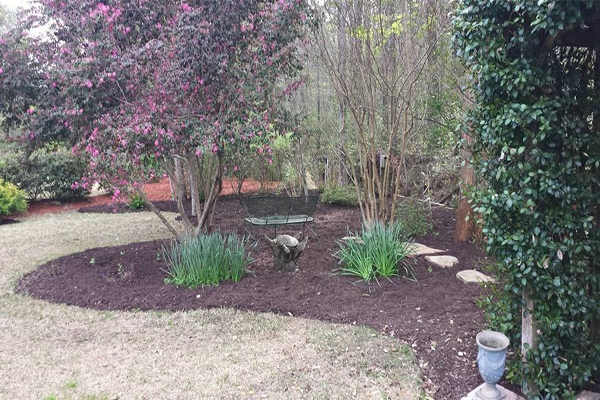Mulching your flower beds and around tress and shrubbery is a good habit to get into to preserve the look and health of your landscape and beds. Mulching is inexpensive and is one of the easiest jobs you can do as a homeowner.
Mulching helps to moderate soil temperature and retain soil moisture which is good for the health of your plants. Adding a layer of mulch to your beds also improves the appearance of your beds and suppresses weed growth.
Taking the time to understand the proper preparation and spreading of mulch can not only make your landscaping beautiful, it can also help with weeds, maintain and improve soil moisture, temperature and aeration, protect tree bases, and even help prevent some plant diseases.
Organic mulches provide nutrients to your plants as they breakdown. Before you start it helps to understand the different types of mulch available, as well as how much mulch to use and when to apply it.
 Steps for Mulching
Steps for Mulching
1 – Cut the Bed — Mulching can quickly spread into your lawn without cutting a landscape bed first. To edge your bed, use a flat edged shovel and cut down about six inches around the edge of your bed.
2 – Weed — This step is not a popular one, but one you shouldn’t skip. Mulching will stop weeds from growing by blocking sunlight to them, but mature weeds can still push through the mulch without sunlight. Make sure to clear the entire area of weeds, and watch that you pull each weed by the roots.
3 – Cover — To further prevent weeds before mulching, lay landscape fabric over the area you’re mulching. Landscape fabric is easy to use and takes just a few minutes to lay out and cut. You might also consider spraying the area with weed control. You can also lay a layer of newspaper 4-6 sheets thick under the mulch, however, newspaper will disintegrate over time.
4 – Use the Right Amount — To determine how many cubic yards of mulch you’ll need, take a rough measurement of your flower beds in square feet. Multiply the rough size of your beds by how deep you want to lay your mulch. Divide this by 324 to find how many cubic yards you need to buy. For example, if your beds measure 10 feet by 32 feet (which equals 320 square feet) and you want to put down a 3-inch layer of mulch, you need 3 cubic yards of mulch (320 x 3 = 960 and 960 / 324 = 3).
5 – Choose the Right Mulch — Hardwood mulches (e.g. Cedar and Cypress) are the most popular and blend easily with other materials. Hardwood mulches, however, do have to be replaced more often due to their quick decomposition.
Bark mulches (e.g. Pine bark mulch) have many of the same qualities as hardwood mulches, but decompose less quickly. They are also natural bug repellents.
6 – Spread Your Mulch — If you buy your mulch in bags, spread the bags out over the area you’re mulching, about every 12 square feet. Cut open the bags and spread evenly using a rake or your hands, working to maintain around a three-inch depth.
If you buy your mulch in bulk, fill a wheelbarrow with mulch, starting with a half a barrow at a time, and remember to work to keep a three inch depth. When doing a large area, start with the area that is furthest from your mulch pile or truck.
Remember to sweep off any leftover much from driveways and sidewalks, as colored much can stain these areas.
If mulching your beds sounds like more of a job than you want to tackle, call the pro’s at Super-Natural Landscaping at 843-246-5598. Or, complete our short form for a free, no-obligation quote on any mulching you need to have done in the Myrtle Beach area. We can help you mulch all your beds and let you just enjoy the view! To get more Myrtle Beach flower garden tips, as well as tips for your overall landscaping projects, visit us on Facebook.

